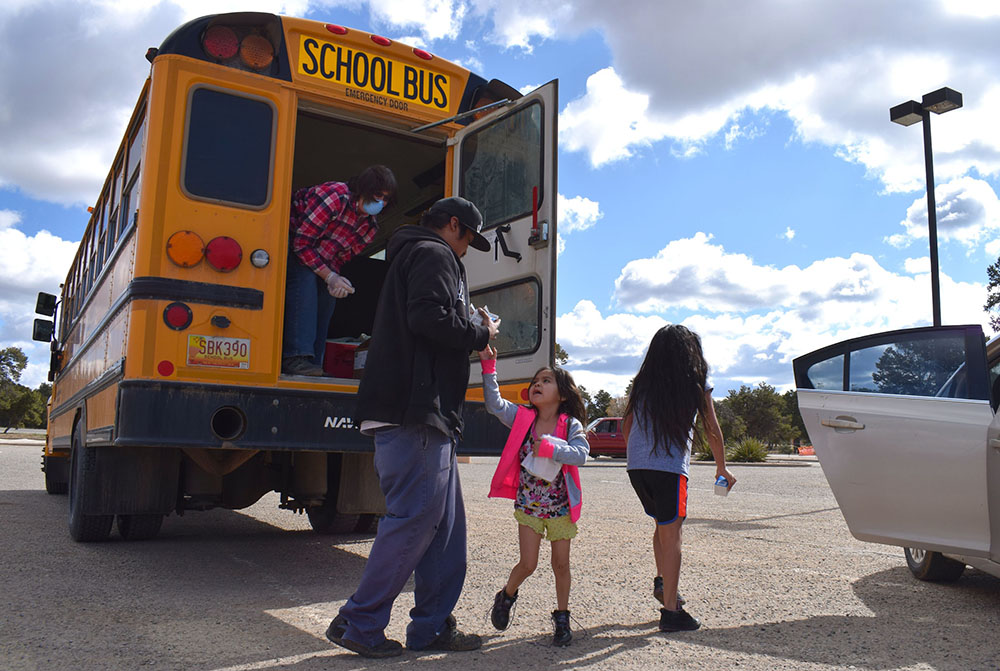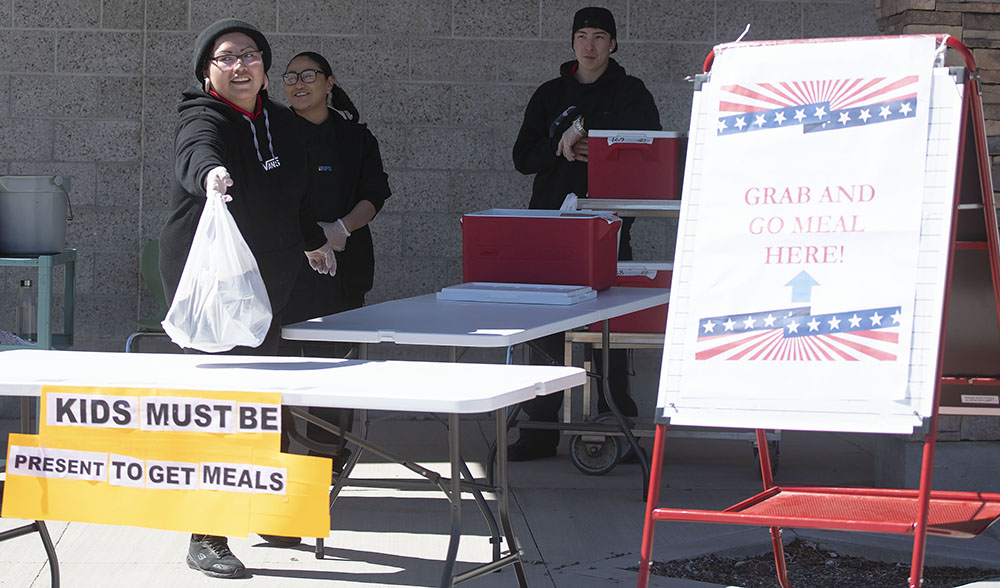
Vida Volkert/Gallup Independent
A Pine Hill, N.M., family receives meals from Shari Lambson, a bus driver for Gallup-McKinley County Schools, on March 30.
The perfect storm analogy might be apropos when assessing the dire situation of Gallup-McKinley County Schools (GMCS) as it attempts to slog through COVID-19 pandemic challenges.
Traditionally, there haven’t been too many high-dollar properties in Gallup that can generate ad valorem tax revenue for the schools. A handful of schools in the district, the most widespread school district in New Mexico and one of the most sparsely populated in the country, according to GMCS Superintendent Mike Hyatt, are more than 40 miles away from the GMCS central offices. (Tsé Yi’ Gai High School on Pintado Pueblo is located approximately 100 miles from the Gallup Commercial Historic District.) And internet access, or even a dependable cellphone connection, is a source of constant frustration for many residents.
When the coronavirus outbreak started taking a heavy toll on the neighboring Navajo Nation, which was one of the hardest-hit areas in the country in April and May, the sudden shift to online learning became a pipe dream for many students.
“All of these things have created a perfect storm where you can really see the disparity,” Hyatt said. “Not only are we not built for online education, but we’re also not funded equitably for technology.”
[Related: NM Schools Providing Academic Coaches, School Packets, Food to Struggling Students]
[Related: State Outreach Helping Aged-out Foster Youth Amid Anxiety About Lost Oil Field Jobs]
[Related: Pandemic Accelerated Rollout of Extended Foster Care ‘in Really Good Way’]
[Related: Mesilla Valley CASA Helping Youth Past CYFD Age Cutoff]
The pandemic has widened the educational achievement gap for Gallup-McKinley County Schools students, many of whom already faced overwhelming socioeconomic challenges and include youth in care. With no tangible end in sight to the spread of the coronavirus, and greater uncertainties about the delivery of education moving forward, the future of public school education in northwest New Mexico is teetering on irreversible ruin.
Tech purchases planned with CARES funds
Hyatt, who didn’t want to further expose vulnerable students to the downstream effects of the pandemic, made the call to conduct distance learning through the mail rather than by virtual classrooms. The novel strategy has its hiccups — he says that GMCS hasn’t been able to reach about 5% of its student body due to housing instability and phone numbers that have been disconnected. He worries that current educational disruptions could stretch far beyond the graduating class of 2020.
“I fear that if we don’t try to get back to some level of normalcy for our students entering our buildings, we’re going to have generations of problems of learning,” Hyatt said. “I’m not sure if that’s always thought about.”
Hyatt’s district doesn’t receive state funding that could specifically address the lack of computer devices for its 11,000 students. At press time, the district was still waiting for $6.8 million from the federal Coronavirus Aid, Relief and Economic Security (CARES) Act.

Alma Hernandez/Gallup Independent
Sasha C., an employee at Jefferson Elementary School in Gallup, N.M., places a bag of school lunches on a table for a family to pick up on March 24.
If and when the money arrives, GMCS plans to purchase new laptops and tablets before the fall semester. As of late June, the New Mexico Public Education Department (PED) was contemplating the most prudent educational setting for the fall semester, scheduled to begin in August.
Hyatt, who says that domestic violence incidents in Gallup have increased during the pandemic, is hoping for at least a partial return to in-person classroom instruction.
“We’ve had more safety issues with students being out of school and out of the buildings than when our students are physically in the buildings,” he said. “I’m sure that’s difficult to weigh for the governor and the Public Education Department.”
Number of unhoused students drops
Hyatt says there have been a number of positive developments for at-risk youth and families. The number of students who have experienced homelessness has dropped — from upwards of 900 kids to a current total of 286 — because a number of area hotels have offered long-stay housing services for youth.
The school district’s food program has served approximately 500,000 meals, which includes daily breakfast, lunch and dinner. Because of the district’s spread-out nature, Hyatt and his staff decided it wasn’t safe for families to travel long distances to centralized grab-and-go meal locations.
Instead, school bus drivers have delivered food to existing bus stops. During Gov. Michelle Lujan Grisham’s 10-day lockdown order of Gallup in early May, local and state government, in tandem with law enforcement, made sure that youth and families were allowed to cross police checkpoints at city boundaries in order to pick up food deliveries, Hyatt said.
GMCS has also faced criticism for some of its responses to the coronavirus outbreak. An anonymous GMCS teacher catalogued a list of pandemic-related grievances against the district, including an alleged gag order from GMCS administrators to cease all phone and email communications with students and families, according to a May 28 report in the Navajo Times (“Policies Do More Harm to Native Students” by Pauly Denetclaw).
Hyatt, GMCS’s superintendent since December 2016, called the allegations “false.”
“We wanted to keep things consistent so that students were getting equal access to their teachers and their schools,” he said. “I read a few lines of the article and realized who it was. It’s a disgruntled employee trying to take jabs at me.”
Hyatt hopes that CARES Act money materializes soon so that every GMCS student has a device in hand in case PED’s fall semester format includes distance learning. Earlier this year, Hyatt and his staff scraped together some money to buy a substantial number of laptops. They took 2½ months to arrive.
“I wish we could order computers and have them here in a week. The procurement process to get devices in that quantity is not easy,” he said. “I suspect that they’re going to barely get here at the first part of this next school year, assuming we get all of the money.”
This story is part of a Youth Today project on foster care in New Mexico. It’s made possible in part by the May and Stanley Smith Charitable Trust. Youth Today is solely responsible for the content and maintains editorial independence.































